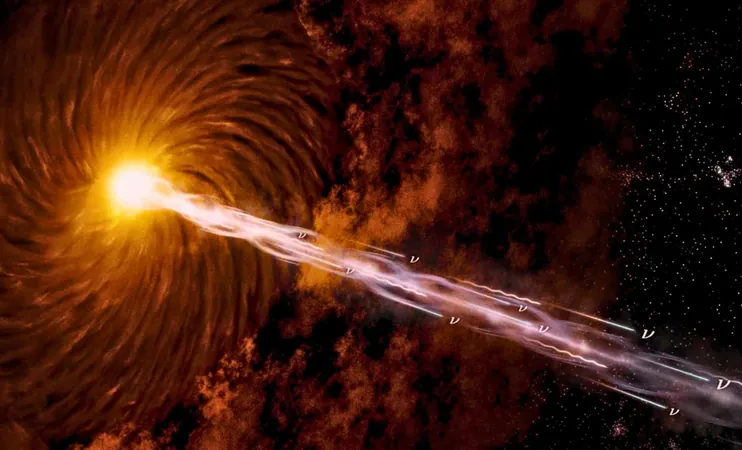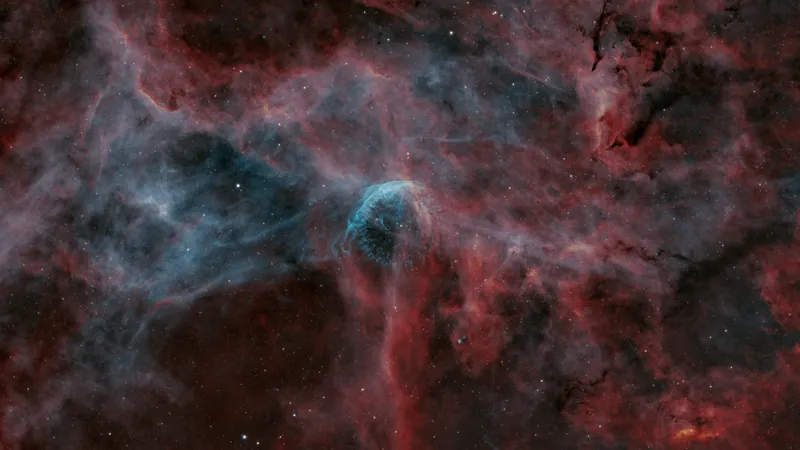
Unraveling the Mysteries of the Universe: Particles from a Distant Blazar Strike Earth!
2024-12-31
Author: Yan
Unraveling the Mysteries of the Universe: Particles from a Distant Blazar Strike Earth!
Humanity has found itself in the cosmic spotlight once again, as powerful particles from a blazar—an extraordinary celestial phenomenon—scream across the universe at near-light speeds. This blazar resides an astounding 13 billion light-years away, marking it as the most distant of its kind ever observed. The incredible find is forcing scientists to rethink their understanding of the cosmos and the evolution of supermassive black holes.
What Exactly is a Blazar?
A blazar isn't your typical celestial body; it's a galaxy that harbors a supermassive black hole at its center, ejecting massive jets of energy directed right at Earth. The newly discovered blazar, known as VLASS J041009.05−2013919.88, existed during a crucial time in cosmic history—just 800 million years after the Big Bang, at a period referred to as the epoch of reionization.
Mind-Blowing Facts about VLASS J041009.05−2013919.88
Discovery Method: This incredible object was identified using the state-of-the-art Karl G. Jansky Very Large Array (VLA) radio telescopes as part of the VLA Sky Survey (VLASS), which meticulously maps 80% of the night sky over seven years.
Imposing Black Hole Mass: With an estimated mass of 700 million solar masses, this black hole dwarf's the famed Sagittarius A*, the supermassive black hole at the center of our Milky Way, which is about 4 million solar masses.
Global Impacts of Cosmic Radiation
The jets from this blazar emit high-energy particles and electromagnetic radiation that surpasses the energy generated by entire galaxies, including our home—the Milky Way. Astrophysicist Emmanuel Momjian from the National Radio Astronomy Observatory (NRAO) states, "This blazar provides a unique laboratory for studying the interplay between jets, black holes, and their environments during a transformative epoch of our universe."
While these ultra-energized particles pose no direct threat to us on Earth, they provoke critical questions about how supermassive black holes can form so rapidly after the Big Bang, changing our understanding of cosmic evolution and growth.
Challenging Established Theories
The discovery of VLASS J041009.05−2013919.88 is not just another numeral; it revolutionizes scientific discourse about black hole formation, dark matter's influence in the early universe, and our fundamental comprehension of cosmic laws. The findings from the James Webb Space Telescope (JWST) and other advanced instruments might hold essential clues for solving these mysteries.
This blazar may have influenced the reionization of the universe's early neutral hydrogen and helium atoms, illuminating an otherwise dark cosmos. As researchers dive deeper into studying its properties using cutting-edge tools like the Very Long Baseline Array (VLBA), Chandra X-ray Observatory, and the Atacama Large Millimeter/submillimeter Array (ALMA), it opens new avenues for understanding cosmic reionization and galaxy evolution.
The Cosmos: A Violent Mystery
VLASS J041009.05−2013919.88 embodies the unpredictable and violent nature of our universe. Its discovery may reshape our scientific perspectives on the early universe, questioning critical theories regarding dark matter, black hole growth, and cosmic physics. As Momjian proclaimed, the exploration of this blazar "raises fundamental questions about how supermassive black holes and galaxies evolved in the early universe."
This astonishing event, where particles from 13 billion light-years away intersect with our reality, serves as a powerful reminder of the boundless mysteries the universe holds. As we continue to explore its depths, who knows what other cosmic surprises are awaiting discovery?

 Brasil (PT)
Brasil (PT)
 Canada (EN)
Canada (EN)
 Chile (ES)
Chile (ES)
 Česko (CS)
Česko (CS)
 대한민국 (KO)
대한민국 (KO)
 España (ES)
España (ES)
 France (FR)
France (FR)
 Hong Kong (EN)
Hong Kong (EN)
 Italia (IT)
Italia (IT)
 日本 (JA)
日本 (JA)
 Magyarország (HU)
Magyarország (HU)
 Norge (NO)
Norge (NO)
 Polska (PL)
Polska (PL)
 Schweiz (DE)
Schweiz (DE)
 Singapore (EN)
Singapore (EN)
 Sverige (SV)
Sverige (SV)
 Suomi (FI)
Suomi (FI)
 Türkiye (TR)
Türkiye (TR)
 الإمارات العربية المتحدة (AR)
الإمارات العربية المتحدة (AR)